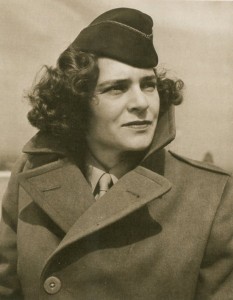Compiled by: Hazel Thompson

Margaret Bourke-White
by John Brown, used under 
Margaret Bourke White was born June 14th, 1904 in Bronx, New York (Oden, 2004). She grew up in Bound Book, New Jersey (Dorfman, 1987), and was the second of three children in her family (Gerber, 2013). Her father, Joseph White, was an engineer. He worked with printing presses, lithography, and rotary press (Dorfman, 1987). Being a big advocator of equal education for men and women, Joseph White pushed Margaret to take school seriously (Oden, 2004). Margaret’s mother, Minnie White, was educated at Pratt Institute in stenography. She always encouraged her children to work hard at their educations and pursue their interests (Dorfman, 1987).
Margaret started off very interested in becoming a scientist, and attended Columbia University to study herpetology (Gerber, 2013). However, her first year at Columbia she took an arts course. Her mother was excited about her taking the course and picked up a camera for Margaret for $20. It was a 3 ¼ x 4 ¼ Ica Reflex with a cracked lens (Oden, 2004). She found that she was good at photography and studied under Clarence White (Loughery, 1989).
She later transferred to University of Michigan where she met Everett Chapman, her future husband (Oden, 2004). She attended seven different universities and studied many different careers always debating the educational route she wanted to take (Gerber, 2013). She finally ended her schooling at Cornell University (Dorfman, 1987).
Margaret could not find a job once graduating and began selling photographs she had taken of the campus. These photographs took off in sales, and it was finally suggested to her that she should pursue photography (Oden, 2004). Margaret went on to have a very successful career that greatly impacted the quality and quantity of historical information available in the United States and Europe from 1930’s till 1950’s.
White was a revolutionary artist and historian. She was the first ever photojournalist. She traveled all around Europe, especially around the time of WWII photographing. Her photos were never poised; the goal was to capture the realism and emotion of the time period (Loughery, 1989). Margaret White was the first U.S. woman allowed to work in combat zones. She was capturing pictures in the frontline; a career that even today is male dominates (Loughery, 1989). She was willing to put herself in any situation regardless of the risk to capture the photograph (Dorfman, 1987).
Margaret’s career came to an end in 1957 when she could no longer take Life Magazine assignments due to Parkinson disease. In 1971 (Dorfman, 1987), Margaret passed away in Stamford Hospital in Stamford Connecticut at 67 years old (Gerber, 2013).
Dorfman, E. (1987, March). Out to Capture the World. Retrieved March 26, 2014, from JSTOR: www.jstor.org/stable/10.2307/4020071?Search=yes&resultitemclick=true&searchText=margaret&searchText=bourke
Gerber, L. (Ed.). (2013, August 13). Margaret Bourke-White. Retrieved March 26, 2014, from Cosmopolis: www.cosmopolis.ch/english/art/e0015700/margaret_bourke_white_e01570000.htm
Loughery, J. (1989). Woman’s Art Journal. Retrieved March 26, 2014, from JSTOR : www.jstor.org/stable/view/10.2307/1358220?Search=yes&resultltemClick=true&searchText=margaret&searchText=bourke
Oden, L. (2004). Margaret Bourke White. Retrieved May 26, 2014, from International Photography Hall of Fame and Museum : www.iphf.org/hall-of-fame/margarer-bourke-white/